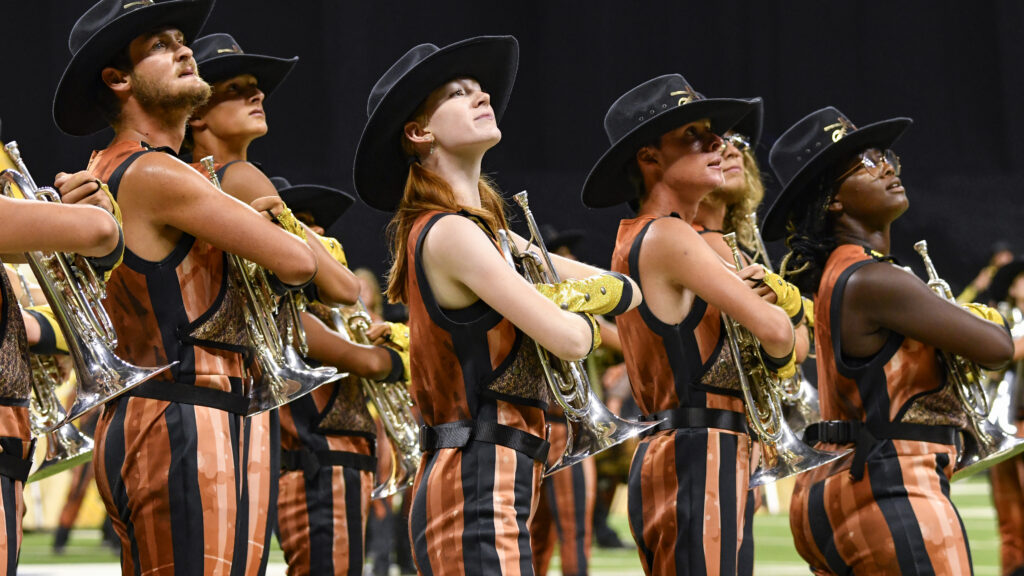The 2002 Madison Scouts are bringing something unique to the field this summer. Those who have had the chance to see them perform may have noticed one of the more rhythmic sections of the “Conquest!” show where a circle forms on the field and the performers begin to execute something of a fight — or is it a dance? or gymnastics? or even a game? It is all of that and then some. Let’s explain.First, a little history. When the conquistadors landed in Central and South America, they cleared the way for centuries of colonization and slavery. Those of us who seek silver linings can think of the martial art of capoeira (kap-o-ay-ra) as one of the positive outcomes to this series of events. For many of the millions of Africans forced into slavery in colonial Brazil, capoeira fed their desire for freedom as it developed into a self-defense form designed from a combination of dance, games and foot-fighting techniques. Perceived as a threat to the European colonizers and thus outlawed, the martial art was set to the rhythmic music of its West African origins and masked as a dance, allowing the continuation of its practice under the watchful eye of the oppressor. Capoeira participants interact with each other, keeping in mind and body a strong community spirit. They “play” together while singing, clapping, playing instruments and supporting those in the circle (the “roda”) playing the game (the “jogo”). The idea is to interact in a relaxed, flowing manner with your partner’s motions and the music. “It’s all about controlling the roda and doing it in a way that’s eloquent and graceful,” explains Madisonian Joe Seitz, capoeira instructor for the Scouts. “You can be belligerent and violent, but no one will want to play with you.”As you watch the Scouts’ performance, watch for some basic and advanced examples of capoeira. The basic dance pattern (the “ginga”) allows the participant to disguise the power of an oncoming attack. Relying primarily on foot techniques, the participant may spin, kick or leap with acrobatic agility, all the while watching and responding to the partner’s own attack. “Capoeira is soft and circular, playful, smooth like water,” says Seitz. “When I first saw it, I knew that I was never going to stop doing it. The energy draws you in, and I love the sound of the music.””What the Scouts are doing on the field is challenging because of the caliber of moves that they are incorporating after just a short amount of training.”Invited by the Scouts to teach capoeira to the guard, Seitz was brought in for four weekends in the preseason. “I was very impressed with what was going on there. They really enjoyed learning and their eagerness to work was so positive. Some were maybe too eager! What they were able to accomplish in a short amount of time was amazing. When I first stepped in, I had no idea of how it was going to be incorporated. I knew a little about drum corps, I had a roommate in the Scouts, but I never really understood it. So I taught them basic skills and a few sequences.” According to Seitz, execution is very important in capoeira, as it is in a drum corps drill.Capoeira is more than a hobby for Seitz. “Wherever I travel, I find capoeira, I find out where it is or I research it before I go.” The same is true for drum corps fans and their passion. In fact, there are many similarities between drum corps and capoeira. Both are comprised of amazing performances that often escape the eye of people unfamiliar with it. Both are competitive yet artistic, both demand a high level of commitment and execution on the part of the participants, both insist upon good sportsmanship, and of course, both are very addictive for all involved. It sounds like capoeira and drum corps are a great combination. Watch the Scouts and decide for yourself but be warned, you too may fall in love with it — and there are no age-outs in capoeira!For those of you curious about your new addiction, there are many capoeira resources on line.By Andrew Irving
- Marching Music's Major LeagueTM





